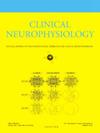核磁共振相关焦虑期间脑呼吸的相互作用
IF 3.6
3区 医学
Q1 CLINICAL NEUROLOGY
引用次数: 0
摘要
用啮齿动物做的实验和病人的颅内脑电图记录显示,鼻腔呼吸可以引起前额叶皮层和边缘系统的快速振荡。最近,研究表明,杏仁核和海马体的活动也可以使用功能磁共振成像(fMRI)进行无创研究。当同时记录BOLD信号、呼吸和心脏RR间期(RRI)时间过程,并应用多元自回归(MVAR)模型与格兰杰因果分析相结合时,就有可能评估大脑结构与身体器官(即心脏和肺)之间的定向耦合或信息流。Klimesch的二元层次模型将伽马和β范围内的快速神经振荡与心脏和呼吸的中频节律以及次慢的BOLD振荡(0.1 Hz)联系起来,所有这些都旨在最大限度地减少大脑的能量需求。该模型预测了三种首选的呼吸频率,0.32 Hz, 0.16 Hz和0.08 Hz,以及0.02 Hz的次慢振荡(ISO)。值得注意的是,在MRI期间,在患者和健康参与者中观察到的优选呼吸频率0.32 Hz(每分钟20次)似乎是焦虑的普遍标志。本文章由计算机程序翻译,如有差异,请以英文原文为准。
Brain-breathing interaction during MRI-related anxiety
Nasal breathing can entrain fast oscillations in the prefrontal cortex and limbic systems, as experiments with rodents and intracranial EEG recordings in patients have shown. Recently, it was demonstrated that the activity of the amygdala and hippocampus can also be studied non-invasively, using functional magnetic resonance imaging (fMRI). When simultaneously recording BOLD signals, respiration and cardiac RR interval (RRI) time courses, and applying a multivariate autoregressive (MVAR) model combined with Granger causality analysis, it becomes possible to assess directed coupling, or information flow, between brain structures and the body organs (i.e., heart and lung).
Klimesch’s binary hierarchy model links fast neural oscillations in the gamma and beta range with medium-range rhythms of the heart and respiration, as well as with infra-slow BOLD oscillations (<0.1 Hz), all aimed to minimize the brain’s energy demands. This model predicts three preferred breathing frequencies, 0.32 Hz, 0.16 Hz, and 0.08 Hz, as well as an infra-slow oscillation (ISO) at 0.02 Hz. Remarkably, the preferred breathing frequency of 0.32 Hz (∼20 cycles per minute) appears to be a universal marker of anxiety, which is observed in patients and healthy participants during MRI sessions.
求助全文
通过发布文献求助,成功后即可免费获取论文全文。
去求助
来源期刊

Clinical Neurophysiology
医学-临床神经学
CiteScore
8.70
自引率
6.40%
发文量
932
审稿时长
59 days
期刊介绍:
As of January 1999, The journal Electroencephalography and Clinical Neurophysiology, and its two sections Electromyography and Motor Control and Evoked Potentials have amalgamated to become this journal - Clinical Neurophysiology.
Clinical Neurophysiology is the official journal of the International Federation of Clinical Neurophysiology, the Brazilian Society of Clinical Neurophysiology, the Czech Society of Clinical Neurophysiology, the Italian Clinical Neurophysiology Society and the International Society of Intraoperative Neurophysiology.The journal is dedicated to fostering research and disseminating information on all aspects of both normal and abnormal functioning of the nervous system. The key aim of the publication is to disseminate scholarly reports on the pathophysiology underlying diseases of the central and peripheral nervous system of human patients. Clinical trials that use neurophysiological measures to document change are encouraged, as are manuscripts reporting data on integrated neuroimaging of central nervous function including, but not limited to, functional MRI, MEG, EEG, PET and other neuroimaging modalities.
 求助内容:
求助内容: 应助结果提醒方式:
应助结果提醒方式:


